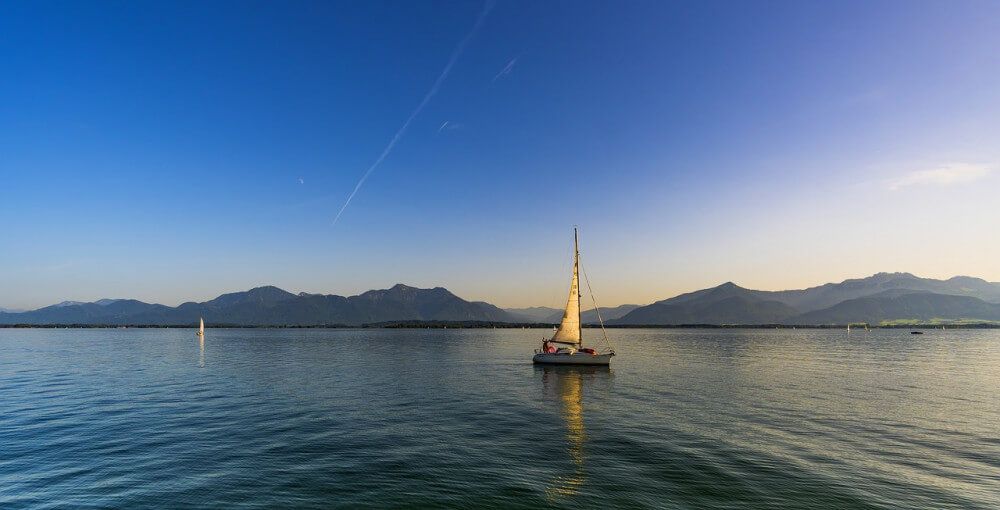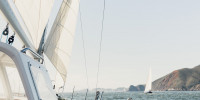What is the Average Speed of a Sailboat?
When I try to figure out the duration of whatever sailing trip I have in the making, I always need to know this one thing first: the average speed of a sailboat - especially with long journeys. If you have the same problem, this article is for you.
So what's the average speed of a sailboat? Most sailboats cruise at a speed of 4-6 knots (4.5-7 mph), with a top speed of 7 knots (8 mph or 13 km/h). Larger racing yachts can easily reach speeds up to 15 knots (17 mph or 28 km/h), with an average cruising speed between 6-8 knots (7-9 mph). Cruising speeds of over 8 knots are uncommon.
Different types of sailboats reach very different speeds. Of course, it all depends on wind conditions, current, and many other factors. Did you know that the speed of a boat is directly related to its length? The larger the boat, the faster it goes. I'll explain it to you later on, but first, more on average speed.

Factors That Determine Speed
So let's get a little more into detail on sailboat speed. The most important factor in determining the speed is the hull type. I have two rules of thumb for you. The first is: the less of the boat is under water, the faster it goes.
Here are the average cruising speeds for different hull types:
- Monohull - 6-8 knots
- Catamaran and trimarans - 9-10 knots
- Fastest monohull (world record circumnavigation) - 15.43 knots
- Fastest trimaran (world record circumnavigation) - 27 knots
Monohull - Your average sailboat is a monohull. Nearly all monohulls are displacement hulls. A displacement hull is under water, pushing the water away. This allows the boat to cut through the water more smoothly; this stabilizes the boat. If you want to make it go faster, you would have to raise the entire hull above the water. Later on I'll show you how to calculate the maximum hull speed of your boat.
Catamarans and Trimarans - These are planing hulls, meaning they are on top of the water. They displace less water, which is why they are faster. But a planing hull is less stable than a displacement hull. To compensate, catamarans and trimarans have two or three hulls, which makes them extremely buoyant. Since this is not your average sailboat I'll leave them out of this article.
The second factor is the length of the boat. It's the second rule of thumb: the longer the boat, the faster it goes. Each sailboat has a maximum hull speed, which it can't exceed (in theory). The hull speed is determined by the length of the boat.
Here are the maximum hull speeds for different monohull lengths:
| length | meters | knots | mph | km/h |
|---|---|---|---|---|
| 16 ft | 5 m | 5 | 5.8 | 9.3 |
| 26 ft | 8 m | 6.8 | 7.8 | 12.6 |
| 36 ft | 11 m | 8 | 9.2 | 14.8 |
| 40 ft | 12 m | 8.5 | 9.8 | 15.7 |
| 65 ft | 20 m | 10.8 | 12.4 | 20 |
| 80 ft | 24 m | 12 | 13.8 | 22.2 |
| 100 ft | 30 m | 13.4 | 15.4 | 24.8 |
| 144 ft | 44 m | 16 | 18.4 | 29.6 |
Please note: the maximum hull speed isn't the average sailing speed. It's the upper limit (in theory - read on to learn more).
The third and perhaps most obvious factor of course is wind direction and speed. If you plan a large voyage, for example, an ocean passage, make sure to check the dominant wind and direction for your time of year. You want to make sure to have as much downwind as you can get, and a favorable current as well. This is why most sailors choose to go eastward instead of westward when sailing the world.
If you want to know why going eastward is smart, I encourage you to read my previous article on sailing around the world here.
Converting and Calculating Sailing Speed
How to calculate necessary sailing speed
So imagine you need to get to dock in time. It's 50 miles away. You need to arrive at 2100 hours. It's currently 1500 hours. Would be handy to know at what speed you need to sail to make it in time.
The formula is simple:
nautical miles / time = average speed necessary
2100 - 1500 = 360 minutes
360 / 60 = 6 hoursYour average speed should be: 50 NM / 6 = 8.3 knots
Converting knots to mph and km/h
To convert knots to mph or km/h, simply multiply the knots by the ratio below.
1 knot = 1.151 mph
1 knot = 1.852 km/h
Calculating the Hull Speed of Your Own Boat
Great, we have a good general idea of what to expect from our trustworthy vessels. If you want to go deeper, you can try to calculate the maximum hull speed of your own boat. Calculating the maximum speed is actually very simple. Now is the time to get out your calculator.
You calculate the maximum hull speed (HS) by taking the length in feet (lwl), get the square root, and multiplying it by 1.34.
HS = √ lwl * 1.34
HS = Hull Speed
lwl = length at waterline
So a 80 feet boat has a maximum hull speed of:
√ 80 * 1.34 = 12 knots
Exceeding Hull Speed
A displacement hull has a maximum hull speed. Hull speed is a theoretical speed that tells us what the maximum efficient speed is. Everything above that speed costs a lot more energy. If you power your boat by engine, you can exceed the speed by pushing the hull over your own bow wave (this requires a lot of horsepowers though, and it isn't good for your engine).
If you're sailing instead, you can exceed your hull speed with the help of the weather. Let's call these surfing conditions (sounds good). This might happen to you when you're sailing downwind and the current pushes you forward simultaneously. This helps you to overtake your own bow wave. If this happens, the wavelength gets longer than the hull length: the water can't get out of the way fast enough. As a result, the boat starts to plane, increasing water resistance at the front. Congratulations: you're surfing on your own bow wave.
The increase in speed won't be mind blowing however (about 1 knot). The truth is: a displacement hull is bound to its speed. It just costs to much energy to propel it through the water. It's made to cut, not steamroll the water.
Amount of Nautical Miles
Sailboats don't travel lightning fast, but they do travel 24/7. Because of this, they can cover quite a bit of distance. What distance are we actually able to cover with conservative speeds?
The average sailboat covers a distance of roughly 100 nautical miles (NM), at a speed of around 4.5 knots. This equals 115 miles or 185 km.
1 NM is 1.852 km or 1.151 mile
You can calculate the distance per day by simply multiplying the speed in knots by 24 hours:
NM = knots * 24
Most sailboats cover anywhere between 100-180 NM per day. This means that a fast sailboat in ideal conditions can cover more than 200 miles. Impressive. However, anything over 180 NM is uncommon. We usually only see cruising speeds that high in races.
Here are the distances per day (NM) for different cruising speeds:
| hull speed | NM | miles | km |
|---|---|---|---|
| 4 | 96 | 111 | 178 |
| 5 | 120 | 115 | 222 |
| 6 | 144 | 166 | 267 |
| 7 | 168 | 190 | 311 |
| 8 | 192 | 221 | 356 |
| 9 | 216 | 249 | 400 |
Related Questions
How fast can a sailboat go under power? The average speed of a sailboat under power is 4-5 knots (5 mph or 8 km/h). Most sailors switch to engine at sailing speeds below 6 knots, especially when on passage.
How fast do racing sailboats go? Racing sailboats can reach speeds of 30 - 50 knots (35-58 mph or 55-92 km/h). The record is set at 65.45 knots (75 mph or 121 km/h). They can beat wind speed because they have a planing hull instead of a displacement hull, making them a lot faster than average sailboats
Can a sailboat sail faster than the wind? Sailboats with a planing hull (multihulls) can go faster than wind. Displacement hulls (the average sailboat) can't beat the wind, or just slightly in surfing conditions.

Did you find the answer to your specific question?
👍 120 👎 7



Comments
Robert Tangney Kenmare Ireland
Just wondering if you could do a similar article on diesel powered boats.I have a Seaward 23 powered with two 1.6 mermaid engines.I normally do around 7_8 knots and was thinking of replacing them for more speed around 10_12 knots.what engines would I need. According to what I have read already I should be getting 10 knots cruising speed with a top speed of 12 knots.This is not the case and her bottom is very clean.Found your article very interesting.
Shawn Buckles
Hi Robert, thanks for your comment. You have quite a bit of power there, nice.
I wouldn’t know for sure what engine size you should get, this article is specifically about sailboats. Also, this is the maximum hull speed - what you could expect under ideal conditions. And that’s never the case - you have to deal with current, wind, and so on. So I’d say it sounds about right.
If by diesel-powered boats you mean a powerboat, I currently don’t write about powerboats. Maybe I will in the future, but I won’t make any promises for now.
Thanks again and good luck with your upgrade!
Ben L
I’m not sure if you use a different way of calculating time in nautical terms (Not a sailor myself, just curious about sailboats), but in the ‘How to calculate necessary sailing speed’ my math would say there’s 6 hours = 360 minutes from 1500 hours (3 PM) to 2100 hours (9 PM), not 600 minutes = 10 hours. Am I missing something?
Shawn Buckles
Hi Ben L,
That’s exactly right, it was a math error on my part. Thanks for pointing it out, I have updated the article.
Passerby
Catamarans and trimarans are PLANING boats?! How long have you been sailing? Three days? :-)))
Matas Pacevicius
Just wanted to point out a typo. At hull speed of 5NM you travel 120NM and 138miles (not the 115 written) per 24hrs. Thank you for your articles. I’ve been dreaming of circumnavigation for years and am in the process of designing and building my own sailboat for the feat. I would love to build and sail a sailboat on which I could live almost anywhere in the world. I currently reside on the Gulf coast of Florida and am surrounded by beautiful warm waters that beckon me to explore them. Hopefully in the followings 5 years I will be sailing into the Caribbean in my self-built traveling home in the water. I wish to call the oceans home and soon the entire world. I plan to cross the Atlantic from the Caribbean on my first leg around the world. Would you recommend sailing throughout the Mediterranean? Any ideas on how’s to make money along the way?
Matt Buse
I’ve worked all my life, struggling. Now 56y.o. staring at becoming a jobless wanderer in the next couple of months, maybe pick up a used boat. I am just really curious how some people have the time and place to design, build, and then sail around. Tell me your secrets…
Benjamin Lindner
Hello Shawn;
You have an error in your table above: 5 Knots = 120 NM BUT DOES NOT EQUAL 115 MILES.
Thank you Ben
Carlos Alberto Molinelli
But WHY is it a maximum speed for displacement boats in quiet waters, responding to this old formula? It is because the speed increases, the water displaced forms waves. At slow speed there are several along the hull. At fast speed there are only two: one at the bow and another an the stern. If the boat tries to go faster, the stern wave would go more farther but the hull would lose sustentation. It better explained with a picture. Look for boats going fast. You will see only two waves.
Robert Flores
Getting close to retirement and want to get a sailboat with some power. Thinking about sailing lakes and coastal. Looking at the macgregor 26M and seaward 26rk. What recommendations do you have ?? Or things to think about. I am one for safety.
Best regards
Robert
Ronald Ernst van Dijk
Thank you. Very well explained in clear language, including the usual conversions between knots, miles and kilometers. It helps understanding the physics of sailboats and what to expect in terms of speed. I have just completed building an 18 feet wooden gaff rigged yawl (design by François Vivier) for single handed coastal sailing in Malaysia, the country where I live. Your “rule of thumb” about HS = Lwl * 1.34 seems to work well, although I have to further try it out with different wind speeds and sailing on a reach or down wind.
Ads
Your website is an ad horror show to the point it is not usable any more. Ads do have their place and purpose, just like food needs salt. But in your case there is more salt then there is food. Moderation is key.
Ara Houston
Hello improvesailing.com owner, You always provide helpful information.
Christa
improvesailing.com
improvesailing.com
Leave a comment